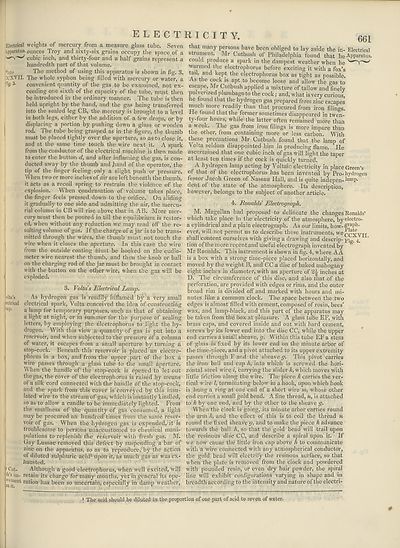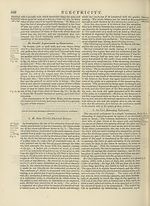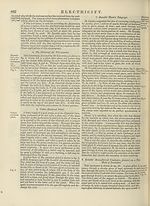Encyclopaedia Britannica > Volume 8, DIA-England
(671) Page 661
Download files
Complete book:
Individual page:
Thumbnail gallery: Grid view | List view

ELECTRICITY.
Electrical weights of mercury from a measure glass tube. Seven
\pparatus. ounces Troy and sixty-six grains occupy the space of a
cubic inch, and thirty-four and a half grains represent a
hundredth part of that volume.
’late The method of using this apparatus is shown in fig. 3.
X'XVII. The whole syphon being filled with mercury or water, a
convenient quantity of the gas to be examined, not ex¬
ceeding one sixth of the capacity of the tube, must then
be introduced in the ordinary manner. The tube is then
held upright by the hand, and the gas being transferred
into tbe sealed leg CB, the mercury is brought to a level
in both legs, either by the addition of a few drops, or by
displacing a portion by pushing down a glass or wooden
rod. The tube being grasped as in the figure, the thumb
must be placed tightly over the aperture, so as to close it,
and at the same time touch the wire next it. A spark
from the conductor of the electrical machine is then made
to enter the button d, and after inflaming the gas, is con¬
ducted away by the thumb and Jiand of tbe operator, the
tip of the finger feeling only a slight push or pressure.
When two or more inches of air are left beneath the thumb,
it acts as a recoil spring to restrain the violence of the
explosion. When condensation of volume takes place,
the finger feels pressed down to the orifice. On sliding
it gradually to one side and admitting the air, the mercu¬
rial column in CB will rise above that in AB. More mer¬
cury must then be poured in till the equilibrium is restor¬
ed, when without any reduction we may read off tbe re¬
sulting volume of gas. If the charge of a jar is to be trans¬
mitted through the wires, the thumb must not touch the
wire when it closes the aperture. In this case the wire
from the outside coating must be hooked on the eudio¬
meter wire nearest the thumb, and then the knob or ball
on the charging rod of the jar must be brought in contact
with the button on the other wire, when the gas will be
exploded.
3. Volta s Electrical Lamp.
As hydrogen gas is readily inflamed by a very small
electrical spark, Volta conceived the idea of constructing
a lamp for temporary purposes, such as that of obtaining
a light at night, or in summer for the purpose of sealing
letters, by employing the electrophorus to light the hy¬
drogen. With this view a quantity of gas is put into a
reservoir, and when subjected to the pressure of a column
of water, it escapes from a small aperture by turning a
stop-cock. Beneath this reservoir is placed an electro¬
phorus in a box, and from the upper part of the box a
wire passes through a glass tube to the small aperture.
When the handle of the stop-cock is opened to let out
the gas, the cover of the electrophorus is raised by means
ot a silk cord connected with the handle of the stop-cock,
and the spark from this cover is conveyed by this insu¬
lated wire to the stream of gas, which is instantly kindled,
so as to allow a candle to be immediately lighted. From
the smallness of the quantity of gas consumed, a light
may be procured an hundred times from the same reser¬
voir of gas. When the hydrogen gas is expended, it is
troublesome to persons unaccustomed to chemical mani¬
pulations to replenish the reservoir with fresh gas. M.
Clay Lussac removed this defect by suspending a bar of
zinc on the apparatus, so as to reproduce, by the action
of diluted sulphuric acid1 upon it, as much gas as was ex¬
hausted.
Although a good eleetrophorus, when well excited, will
retain its charge for many months, yet in general its ope¬
ration has been so uncertain, especially in damp weather,
661
nlta’s
ectrical
Imp.
r Cut-
sh’s im¬
minent
>n it.
that many persons have been obliged to lay aside the in- Electrical
strument. Mr Cutbush of Philadelphia found that he Apparatus,
could produce a spark in the dampest weather when he v—
warmed the electrophorus before exciting it with a fox’s
tail, and kept the electrophorus box as tight as possible.
As the cock is apt to become loose and allow the gas to
escape, Mr Cutbush applied a mixture of tallow and finely
pulverized plumbago to the cock; and, what is very curious,
le found that the hydrogen gas prepared from zinc escapes
much more readily than that procured from iron filings.
He found that the former sometimes disappeared in twen¬
ty-four hours, while the latter often remained more than
a week. The gas from iron filings is more impure than
the other, from containing more or less carbon. With
these precautions Mr Cutbush found that the lamp of
Volta seldom disappointed him in producing flame. He
ascertained that one cubic inch of gas will light the taper
at least ten times if the cock is quickly turned.
A hydrogen lamp acting by Voltaic electricity in place Green’s
of that of the electrophorus has been invented by Pro-hydrogen
fessor Jacob Green of Nassau Hall, and is quite indepen-lamP-n
dent of the state of the atmosphere. Its description,
however, belongs to the subject of another article.
4. Ronalds Electrograph.
M. Magellan had proposed to delineate the changes Ronalds’
which take place in the electricity of the atmosphere, byelectro-
a cylindrical and a plain electrograph. As our limits, how-graPh*
ever, will not permit us to describe these instruments, we£^yir
shall content ourselves with giving a drawing and descrip- 4> ‘
tion of the more recent and useful electrograph invented by
Mr Ronalds. This instrument is shown in fig. 4, where AA
is a box with a strong time-piece placed horizontally, and
moved by the weight B, and CC a disc of baked mahogany
eight inches in diameter, with an aperture of 21 inches at
D. The circumference of this disc, and also that of the
perforation, are provided with edges or rims, and the outer
broad rim is divided off and marked with hours and mi¬
nutes like a common clock. The space between the two
edges is almost filled with cement, composed of rosin, bees’
wax, and lamp-black, and this part of the apparatus may
be taken from tbe box at pleasure. A glass tube EF, with
brass caps, and covered inside and out with hard cement,
screws by its lower end into the disc CC, while the upper
end carries a small sheave, g. Within this tube EF a stem
of glass is fixed by its lower end on the minute arbor of
the time-piece, and a pivot attached to its upper extremity
passes through F and the sheave g. This pivot carries
the iron ball and cap h, into which is screwed the hori¬
zontal steel wire i, carrying the slider k, which moves with
little friction along the wire. The piece k carries the ver¬
tical wire l, terminating below in a hook, upon which hook
is hung a ring at one end of a short wire m, whose other
end carries a small gold bead. A fine thread, n, is attached
to k by one end, and by the other to the sheave g.
When the clock is going, its minute arbor carries round
the arm k, and the effect of this is to coil the thread n
round the fixed sheave g, and to make the piece k advance
towards the ball h, so that the gold bead will trail upon
the resinous disc CC, and describe a spiral upon it. If
we now cause the little iron cap above h to communicate
with a wire connected With any atmospherical conductor,
the gold bead will electrify the resinous surface, so that
when the plate is removed from the clock and powdered
with pounded resin, or even dry hair powder, the spiral
line will exhibit configurations varying in shape and in
breadth according to the intensity and nature of the electri-
1 The acid should be diluted in the proportion of one part of acid to seven of water.
Electrical weights of mercury from a measure glass tube. Seven
\pparatus. ounces Troy and sixty-six grains occupy the space of a
cubic inch, and thirty-four and a half grains represent a
hundredth part of that volume.
’late The method of using this apparatus is shown in fig. 3.
X'XVII. The whole syphon being filled with mercury or water, a
convenient quantity of the gas to be examined, not ex¬
ceeding one sixth of the capacity of the tube, must then
be introduced in the ordinary manner. The tube is then
held upright by the hand, and the gas being transferred
into tbe sealed leg CB, the mercury is brought to a level
in both legs, either by the addition of a few drops, or by
displacing a portion by pushing down a glass or wooden
rod. The tube being grasped as in the figure, the thumb
must be placed tightly over the aperture, so as to close it,
and at the same time touch the wire next it. A spark
from the conductor of the electrical machine is then made
to enter the button d, and after inflaming the gas, is con¬
ducted away by the thumb and Jiand of tbe operator, the
tip of the finger feeling only a slight push or pressure.
When two or more inches of air are left beneath the thumb,
it acts as a recoil spring to restrain the violence of the
explosion. When condensation of volume takes place,
the finger feels pressed down to the orifice. On sliding
it gradually to one side and admitting the air, the mercu¬
rial column in CB will rise above that in AB. More mer¬
cury must then be poured in till the equilibrium is restor¬
ed, when without any reduction we may read off tbe re¬
sulting volume of gas. If the charge of a jar is to be trans¬
mitted through the wires, the thumb must not touch the
wire when it closes the aperture. In this case the wire
from the outside coating must be hooked on the eudio¬
meter wire nearest the thumb, and then the knob or ball
on the charging rod of the jar must be brought in contact
with the button on the other wire, when the gas will be
exploded.
3. Volta s Electrical Lamp.
As hydrogen gas is readily inflamed by a very small
electrical spark, Volta conceived the idea of constructing
a lamp for temporary purposes, such as that of obtaining
a light at night, or in summer for the purpose of sealing
letters, by employing the electrophorus to light the hy¬
drogen. With this view a quantity of gas is put into a
reservoir, and when subjected to the pressure of a column
of water, it escapes from a small aperture by turning a
stop-cock. Beneath this reservoir is placed an electro¬
phorus in a box, and from the upper part of the box a
wire passes through a glass tube to the small aperture.
When the handle of the stop-cock is opened to let out
the gas, the cover of the electrophorus is raised by means
ot a silk cord connected with the handle of the stop-cock,
and the spark from this cover is conveyed by this insu¬
lated wire to the stream of gas, which is instantly kindled,
so as to allow a candle to be immediately lighted. From
the smallness of the quantity of gas consumed, a light
may be procured an hundred times from the same reser¬
voir of gas. When the hydrogen gas is expended, it is
troublesome to persons unaccustomed to chemical mani¬
pulations to replenish the reservoir with fresh gas. M.
Clay Lussac removed this defect by suspending a bar of
zinc on the apparatus, so as to reproduce, by the action
of diluted sulphuric acid1 upon it, as much gas as was ex¬
hausted.
Although a good eleetrophorus, when well excited, will
retain its charge for many months, yet in general its ope¬
ration has been so uncertain, especially in damp weather,
661
nlta’s
ectrical
Imp.
r Cut-
sh’s im¬
minent
>n it.
that many persons have been obliged to lay aside the in- Electrical
strument. Mr Cutbush of Philadelphia found that he Apparatus,
could produce a spark in the dampest weather when he v—
warmed the electrophorus before exciting it with a fox’s
tail, and kept the electrophorus box as tight as possible.
As the cock is apt to become loose and allow the gas to
escape, Mr Cutbush applied a mixture of tallow and finely
pulverized plumbago to the cock; and, what is very curious,
le found that the hydrogen gas prepared from zinc escapes
much more readily than that procured from iron filings.
He found that the former sometimes disappeared in twen¬
ty-four hours, while the latter often remained more than
a week. The gas from iron filings is more impure than
the other, from containing more or less carbon. With
these precautions Mr Cutbush found that the lamp of
Volta seldom disappointed him in producing flame. He
ascertained that one cubic inch of gas will light the taper
at least ten times if the cock is quickly turned.
A hydrogen lamp acting by Voltaic electricity in place Green’s
of that of the electrophorus has been invented by Pro-hydrogen
fessor Jacob Green of Nassau Hall, and is quite indepen-lamP-n
dent of the state of the atmosphere. Its description,
however, belongs to the subject of another article.
4. Ronalds Electrograph.
M. Magellan had proposed to delineate the changes Ronalds’
which take place in the electricity of the atmosphere, byelectro-
a cylindrical and a plain electrograph. As our limits, how-graPh*
ever, will not permit us to describe these instruments, we£^yir
shall content ourselves with giving a drawing and descrip- 4> ‘
tion of the more recent and useful electrograph invented by
Mr Ronalds. This instrument is shown in fig. 4, where AA
is a box with a strong time-piece placed horizontally, and
moved by the weight B, and CC a disc of baked mahogany
eight inches in diameter, with an aperture of 21 inches at
D. The circumference of this disc, and also that of the
perforation, are provided with edges or rims, and the outer
broad rim is divided off and marked with hours and mi¬
nutes like a common clock. The space between the two
edges is almost filled with cement, composed of rosin, bees’
wax, and lamp-black, and this part of the apparatus may
be taken from tbe box at pleasure. A glass tube EF, with
brass caps, and covered inside and out with hard cement,
screws by its lower end into the disc CC, while the upper
end carries a small sheave, g. Within this tube EF a stem
of glass is fixed by its lower end on the minute arbor of
the time-piece, and a pivot attached to its upper extremity
passes through F and the sheave g. This pivot carries
the iron ball and cap h, into which is screwed the hori¬
zontal steel wire i, carrying the slider k, which moves with
little friction along the wire. The piece k carries the ver¬
tical wire l, terminating below in a hook, upon which hook
is hung a ring at one end of a short wire m, whose other
end carries a small gold bead. A fine thread, n, is attached
to k by one end, and by the other to the sheave g.
When the clock is going, its minute arbor carries round
the arm k, and the effect of this is to coil the thread n
round the fixed sheave g, and to make the piece k advance
towards the ball h, so that the gold bead will trail upon
the resinous disc CC, and describe a spiral upon it. If
we now cause the little iron cap above h to communicate
with a wire connected With any atmospherical conductor,
the gold bead will electrify the resinous surface, so that
when the plate is removed from the clock and powdered
with pounded resin, or even dry hair powder, the spiral
line will exhibit configurations varying in shape and in
breadth according to the intensity and nature of the electri-
1 The acid should be diluted in the proportion of one part of acid to seven of water.
Set display mode to:
![]() Universal Viewer |
Universal Viewer | ![]() Mirador |
Large image | Transcription
Mirador |
Large image | Transcription
Images and transcriptions on this page, including medium image downloads, may be used under the Creative Commons Attribution 4.0 International Licence unless otherwise stated. ![]()
| Encyclopaedia Britannica > Encyclopaedia Britannica > Volume 8, DIA-England > (671) Page 661 |
|---|
| Permanent URL | https://digital.nls.uk/193331728 |
|---|
| Attribution and copyright: |
|
|---|
| Description | Ten editions of 'Encyclopaedia Britannica', issued from 1768-1903, in 231 volumes. Originally issued in 100 weekly parts (3 volumes) between 1768 and 1771 by publishers: Colin Macfarquhar and Andrew Bell (Edinburgh); editor: William Smellie: engraver: Andrew Bell. Expanded editions in the 19th century featured more volumes and contributions from leading experts in their fields. Managed and published in Edinburgh up to the 9th edition (25 volumes, from 1875-1889); the 10th edition (1902-1903) re-issued the 9th edition, with 11 supplementary volumes. |
|---|---|
| Additional NLS resources: |
|

